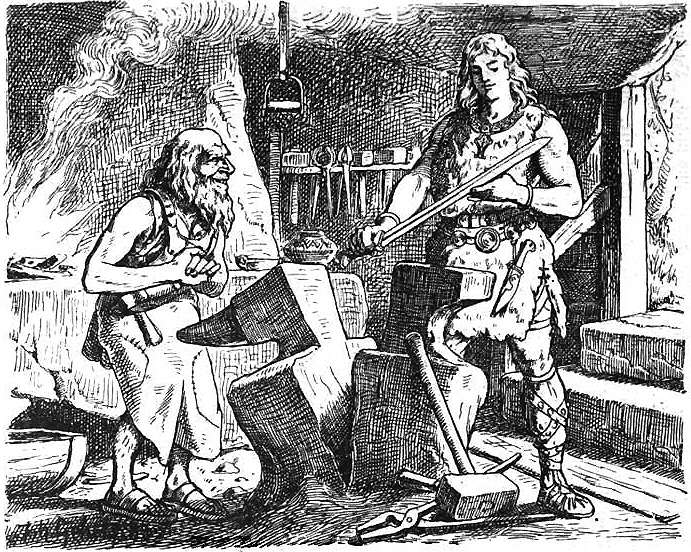Blog
Lesser-Known Viking Sword Legends: Myths and Mysteries

The Viking Age, spanning from the late 8th to early 11th centuries, is renowned for its fearless warriors and iconic weaponry. Among these, Lesser – known Viking sword legends stand out, highlighting the mystique and power these weapons held in Norse culture. While swords like the famous Ulfberht are well-known, there are many lesser-known Viking swords with fascinating stories steeped in Norse mythology swords. In this blog, we’ll explore the myths and truths behind these historical Viking swords and their enduring allure.
The Skofnung Sword: A Cursed Legacy
The legend of the Skofnung sword, one of the most mysterious best Viking sword myths, claims it belonged to the Danish king Hrólfr Kraki. This legendary blade was famous for its unmatched sharpness and strength. Making it one of the most feared weapons of its time.
However, the Skofnung sword legend also speaks of a curse. Only a “worthy” wielder could draw the sword from its sheath, and if misused. It would bring great misfortune to its owner. Some sagas suggest the sword housed the spirits of Hrólfr’s warriors, infusing it with supernatural power. This tale firmly places Skofnung among the most intriguing lesser-known Viking swords revered for their mystique.
The Sword of Hjalmar: A Tale of Love and Valor
Another fascinating tale is that of Hjalmar’s sword, carried by the Viking warrior in a saga of loyalty and devotion. Known for its unmatched durability, the sword was forged by an unknown master.
Hjalmar used it in a tragic duel against Orvar-Odd, symbolizing his love for his princess. This story highlights how historical Viking swords were not just weapons but symbols of honor, sacrifice, and deep emotional ties.
Gram: The Dragon Slayer Sword
Image credit by wiki
The Gram Dragon Slayer sword is among the most legendary Norse mythology swords, famously wielded by Sigurd, the slayer of the dragon Fafnir. The gods allegedly forged this mythical blade, crafting it to aid Sigurd in his heroic quest.
Gram’s story remains one of the most celebrated Viking sword legends, inspiring numerous adaptations in modern media. Whether featured in games like Assassin’s Creed Valhalla or referenced in movies. The Gram Dragon Slayer sword embodies the perfect blend of myth and history, solidifying its place in both Viking sword myths and popular culture.
Mystical Beliefs Surrounding Viking Swords
Norse mythology swords were deeply intertwined with Viking spirituality and culture. Swords often carried names, emphasizing their unique personalities and powers. People saw some swords as “bloodthirsty,” cursed to harm their owners, while others were believed to grant divine protection.
Vikings forged these historical swords with a blend of practical skill and alleged black magic, earning them a reputation as master craftsmen shrouded in mystery. Some of the swords depicted engravings along the blade, especially runic inscriptions as a protection from gods in the pre-Viking age. Norwegian authenticity of some swords based on the Runic writings inscribed in the blade mounted the mythical aspect on the swords.
The Forgotten Craftsmanship Behind Viking Swords
Although Ulfberht Viking swords showcase the Vikings’ advanced metallurgy, other less famous Viking swords also display exceptional craftsmanship. From other ancient Scandinavians, the Viking smiths made great use of high-quality steel and unique forging patterns to produce not only functional and effective weapons but also metals that, in their own right, were works of art.
These swords often featured runic inscriptions, believed to invoke protection or grant strength to their wielder. This intricate artistry reinforces the belief that Viking swords were more than mere tools—they were symbols of divine favor and personal identity, shaping their place in lesser – known Viking sword legends.
Modern Influence of Viking Sword Myths
Today, these Viking sword myths and sagas continue to inspire modern culture. Power-packed games like Assassin’s Creed Valhalla and historical dramas like Vikings showcase the fascinating history of lesser-known Viking swords. Collectors and historians actively seek these artifacts to uncover their history and craftsmanship.
Exploring these legends not only enriches our understanding of Viking heritage but also highlights the enduring connection between history and myth. For enthusiasts, these tales offer a window into a world where swords symbolized more than warfare—they represented honor, destiny, and the spirit of a people.
Conclusion: Why Viking Sword Legends Matter
It is much more beneficial to study the Viking sword legends that are not as widely famous as Mjölnir – these are Skofnung, the Sword of Hjalmar, and Gram. These tales present how Norse mythology swords were not only tools of battle but also vessels of identity and mythology.
What we find here are more correctly, the less known Viking sagas, and it is in these obscure tales of yore, that the thrust of Viking endeavors exist. If you are a myth enthusiast, history lover, or collector. The stories behind these Viking sword legends remain fascinating to this feast and are lessons in bravery, partisanship, and lore.

